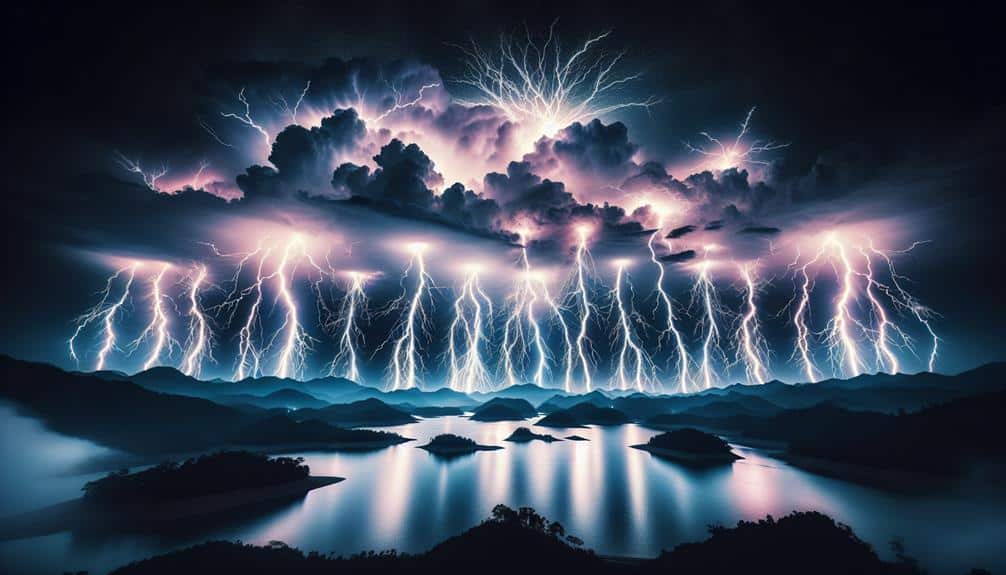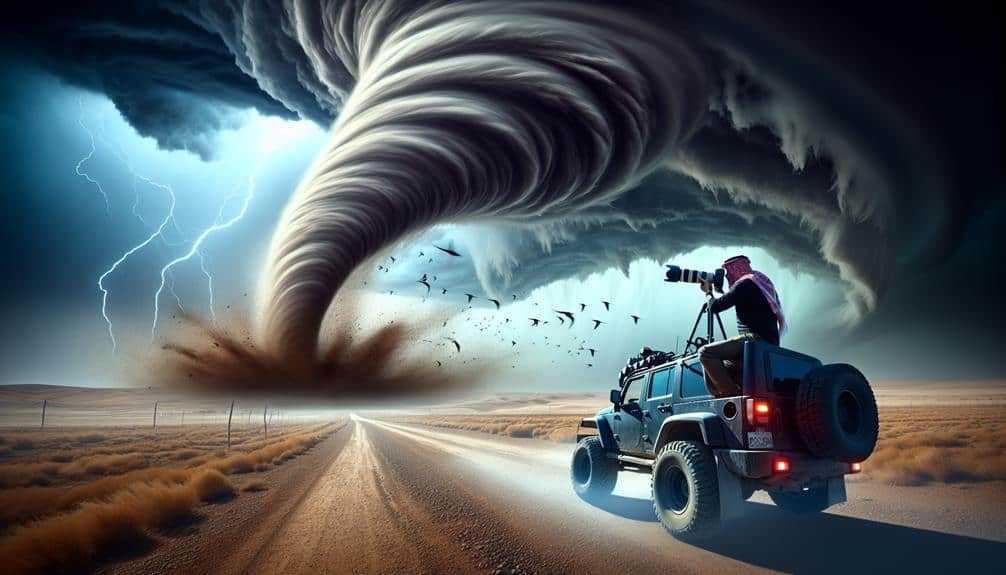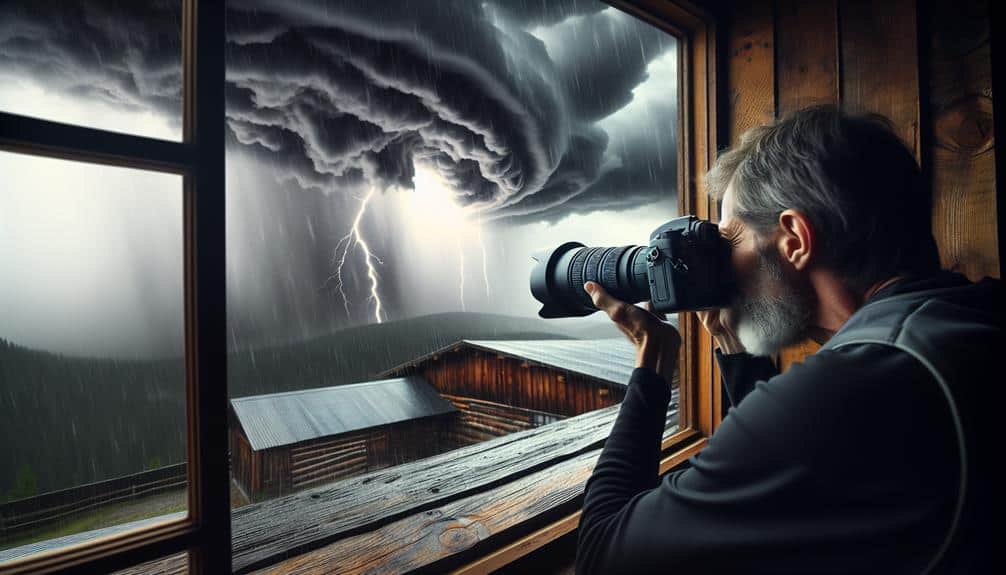We safeguard our camera gear in extreme weather by using weather-resistant camera bags with shock-absorbing cases and reinforced corners to shield against harsh conditions. We apply protective lens filters to keep lenses pristine and use desiccants to manage moisture. Waterproof covers safeguard against heavy downpours, while anti-fogging solutions maintain clarity in humid environments. Cold weather requires battery care, and high winds call for stabilizing tripods and wind-resistant bags. Regular maintenance, including drying and cleaning techniques, ensures our gear stays in top-notch condition. For an in-depth look at safeguarding your gear, keep following our detailed strategies and tips.
Key Points
- Use weatherproof camera bags with shockproof cases and reinforced corners.
- Utilize desiccants to control moisture and prevent condensation inside gear.
- Attach protective lens filters to maintain lens clarity in harsh conditions.
- Employ waterproof covers and cases to shield cameras during heavy rain.
Weatherproof Camera Bags
Investing in weatherproof camera bags is necessary for safeguarding our gear from harsh environmental conditions. When we're out in the field, facing unpredictable weather, our equipment needs sturdy protection. Shockproof cases are a necessity to guard against drops and impacts. These cases often come with reinforced corners and padded interiors, ensuring our cameras and lenses remain intact even if bumped.
Dustproof backpacks are another essential component. These backpacks are designed with weather sealed compartments that prevent dust, sand, and moisture from infiltrating and damaging our gear. The zippers and seams are meticulously crafted to offer a tight seal, providing peace of mind when we're trekking through dusty trails or sandy beaches.
Moreover, it's important to look for bags with impact resistant shells. These shells offer an additional layer of protection, absorbing shocks and preventing external pressure from harming our equipment. This feature is particularly valuable when we're maneuvering rugged terrains or transporting our gear in crowded places.
Protective Lens Filters
While our camera bags offer significant protection, incorporating protective lens filters into our gear guarantees our lenses remain pristine and free from damage during extreme weather conditions. These filters act as the first line of defense against elements like rain, snow, and dust, ensuring our primary lens surfaces remain untouched.
When it comes to protective filter options, UV filters are a popular choice for their ability to block ultraviolet rays and protect against scratches. Meanwhile, clear protective filters provide strong physical protection without altering the image quality. Polarizing filters can also enhance image contrast while safeguarding the lens from moisture and debris.
Our lens care techniques don't stop at simply attaching a filter. Proper filter maintenance is essential. Regularly clean and inspect the filters to make sure they remain free from smudges and scratches. Utilize a blower brush to remove loose particles, followed by a microfiber cloth for a thorough clean.
For lens protection tips, always screw the filter on securely to prevent it from loosening in harsh conditions. Store filters in a protective case when not in use to avoid any accidental damage. By integrating these protective filters and maintenance practices, we can confidently face extreme weather, knowing our lenses are shielded and ready for action.
Waterproof Camera Covers
To ensure our cameras remain dry and operational in extreme weather, waterproof camera covers are an essential part of our protective gear arsenal. These camera rain covers act as a barrier against water, ensuring that our equipment continues to function even in heavy downpours. They're designed to fit snugly over cameras and lenses, offering thorough protection without obstructing access to controls.
For those of us venturing into particularly harsh environments, investing in waterproof camera cases is non-negotiable. These cases provide a higher level of camera gear protection, shielding our valuable equipment from not just water, but also dust, mud, and other potentially damaging elements. They come in various sizes, accommodating everything from compact cameras to professional DSLRs with telephoto lenses.
Weatherproof camera accessories like these are essential for photographers who crave freedom and adventure. They allow us to shoot in diverse conditions without compromising the integrity of our gear.
When choosing a cover or case, we should consider the specific challenges of our shooting environment, ensuring the material and design offer maximum protection. By integrating these measures, we can confidently capture stunning images, regardless of the weather.
Desiccants and Anti-Fogging
Let's focus on how to keep our camera gear dry and fog-free with efficient desiccants and anti-fogging solutions.
We'll explore various desiccant options that absorb moisture efficiently, ensuring our equipment stays in top condition.
Additionally, we'll cover the best anti-fogging treatments and storage tips to maintain clarity and functionality in extreme weather conditions.
Choosing Effective Desiccants
Selecting the right desiccants is crucial for preventing moisture buildup and fogging in camera gear, especially in challenging weather conditions. When we talk about desiccant effectiveness, silica gel stands out as a top choice. Its high absorption capacity guarantees optimal moisture control, keeping our gear safe from the harmful effects of humidity. Placing silica gel packets inside camera bags, lens cases, and storage boxes is a practical step for camera gear preservation.
We must also consider molecular sieves, which provide superior humidity protection. These synthetic zeolites offer a strong defense against moisture, especially in extreme environments. Their uniform pore size allows for efficient moisture absorption, making them invaluable for long-term storage.
Furthermore, clay desiccants, though less common, can be surprisingly efficient. They're natural, non-toxic, and provide reliable moisture control in moderate conditions. Their affordability makes them an appealing option for those looking to balance cost and performance.
In addition to choosing the right desiccant, we should regularly replace or recharge them to maintain efficiency. Desiccants saturated with moisture won't offer the protection our camera gear needs. By prioritizing these measures, we guarantee our equipment remains operational and ready for any adventure, regardless of the weather.
Anti-Fogging Solutions Overview
In the domain of camera gear protection, combining drying agents with specialized anti-fogging solutions provides an all-encompassing defense against the harmful effects of moisture and condensation. To optimize our equipment's performance in extreme conditions, we must adopt a dual approach that emphasizes both moisture absorption and fog prevention.
Drying agents like silica gel packs are our first line of defense. These small, potent agents absorb excess humidity, keeping our gear dry. However, to address the specific challenge of fogging, especially on lenses, we need to implement advanced anti-fogging techniques.
Applying an anti-fogging solution or spray to our lens surfaces creates a barrier that minimizes the condensation that can form when moving between temperature extremes. Lens maintenance is essential in these scenarios. Regularly cleaning and reapplying anti-fogging solutions ensures our lenses remain clear and functional.
Additionally, using camera gear care accessories like lens hoods can provide extra protection against the elements. By integrating these methods, we can confidently capture stunning images regardless of the weather conditions.
In essence, a combination of drying agents and anti-fogging solutions is vital for maintaining the integrity and performance of our camera gear in extreme conditions.
Storage Tips for Cameras
To ensure our camera gear remains in best condition when stored, we must strategically use desiccants and apply anti-fogging treatments. Efficient humidity control and proper equipment organization are essential to protect our valuable gear from the detrimental effects of moisture.
Here's how we can achieve optimal gear protection:
- Desiccants: Place silica gel packets inside camera bags and storage cases. These desiccants absorb excess moisture, ensuring moisture prevention and reducing the risk of mold and corrosion.
- Anti-Fogging Treatments: Use anti-fogging solutions on lenses and viewfinders. These treatments create a protective layer that minimizes condensation, essential for maintaining clear visibility in humid environments.
- Airtight Storage Containers: Store our cameras and lenses in airtight containers to further enhance moisture prevention. This creates a controlled environment that limits exposure to humidity.
- Regular Inspections: Frequently check and replace desiccants and reapply anti-fogging treatments. This ensures continuous gear protection and maintains the effectiveness of our storage solutions.
Battery Performance in Cold
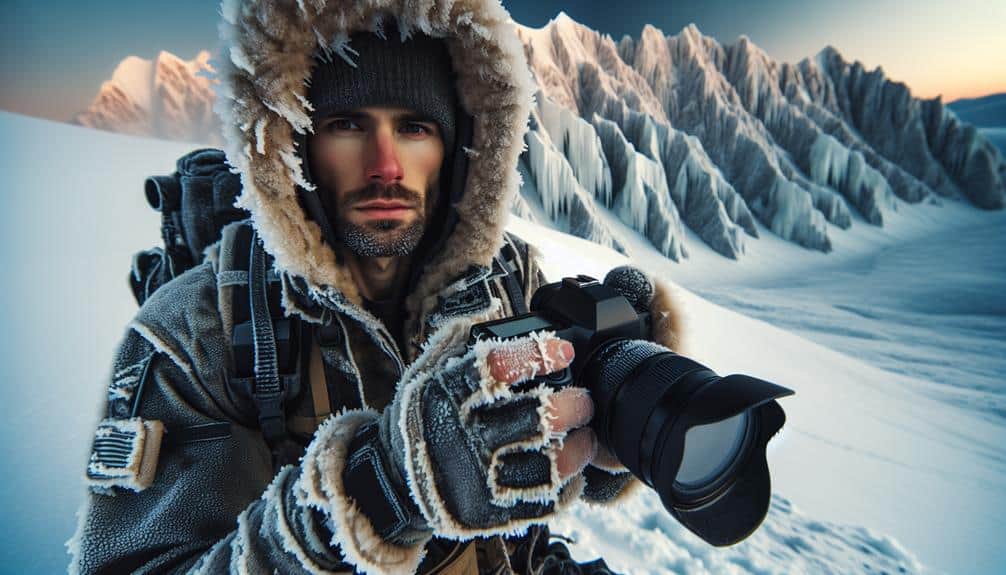
Cold temperatures notably reduce the efficiency of camera batteries, requiring specific strategies to maintain peak performance. To guarantee battery longevity in extreme cold, we need to understand the temperature impact on battery performance. Lithium-ion batteries, commonly used in cameras, lose their charge faster when exposed to frigid conditions. This happens because the chemical reactions within the battery slow down at lower temperatures, diminishing their capacity.
One effective method to combat this is to keep spare batteries close to our body. Our body heat helps maintain their operational temperature. When one battery depletes, we can swiftly swap it with a warm one, thereby minimizing downtime. Additionally, insulating battery compartments with specialized thermal covers can provide further protection against the cold.
We should also consider pre-charging all batteries to their maximum capacity before venturing into cold environments. Cold can also cause batteries to display incorrect charge levels, leading to unexpected power loss. Carrying a portable charger guarantees we've a backup power source if needed.
Lastly, avoid exposing batteries to extreme temperature fluctuations, which can lead to condensation and potential short-circuiting. Through these proactive measures, we can significantly improve battery performance and reliability in harsh weather conditions.
Securing Gear in High Winds
When working in high winds, we must make sure our tripods and monopods are properly stabilized to prevent camera shake and potential damage.
Using weight bags or ground spikes can greatly enhance stability.
Additionally, selecting wind-resistant camera bags will keep our gear secure and protected from sudden gusts.
Stabilizing Tripods and Monopods
Securing our tripods and monopods in high winds demands not only strategic placement but also the use of additional stabilizing tools like sandbags, ground anchors, and weighted hooks. Tripod stabilization becomes critical in adverse weather conditions to avoid blurred shots and potential equipment damage. We must make sure our tripods are firmly grounded and resistant to sudden gusts.
When dealing with monopod support in extreme temperatures, it's crucial to take into account both the stability and the material's resilience. Monopods, while lighter and more portable, require thoughtful support mechanisms to stay steady.
Here are four essential techniques to stabilize our tripods and monopods:
- Sandbags: Place these at the base of the tripod to add weight and lower the center of gravity, providing enhanced stability.
- Ground Anchors: Use these to secure the tripod legs firmly into soft ground, preventing any movement due to strong winds.
- Weighted Hooks: Attach weights to the tripod's central column to counterbalance and stabilize the setup.
- Spiked Feet: Equip tripod legs with spiked feet to grip onto uneven or slippery surfaces, ensuring a solid hold.
Wind-Resistant Camera Bags
In high winds, we rely on wind-resistant camera bags with reinforced seams and secure closures to protect our valuable gear from the elements. These bags are engineered to withstand the most challenging conditions.
Impact resistant backpacks are essential for adventurers who refuse to be confined by weather limitations. Their robust construction and padded compartments safeguard our equipment from sudden gusts and accidental drops, ensuring that our gear remains intact.
Dustproof camera cases offer an additional layer of security by preventing fine particles from infiltrating our gear. High winds are notorious for kicking up dust and debris, which can wreak havoc on delicate camera components. By using these specialized cases, we minimize the risk of damage and extend the longevity of our equipment.
Moreover, the design of wind-resistant camera bags often includes aerodynamic shapes and adjustable straps. This reduces drag and offers a more comfortable carrying experience, even in the fiercest of winds.
Adjustable sternum and waist straps help distribute weight evenly, enhancing stability and reducing the strain on our bodies. Essentially, these bags empower us to pursue our passion for photography, regardless of the weather conditions.
Drying and Cleaning Techniques
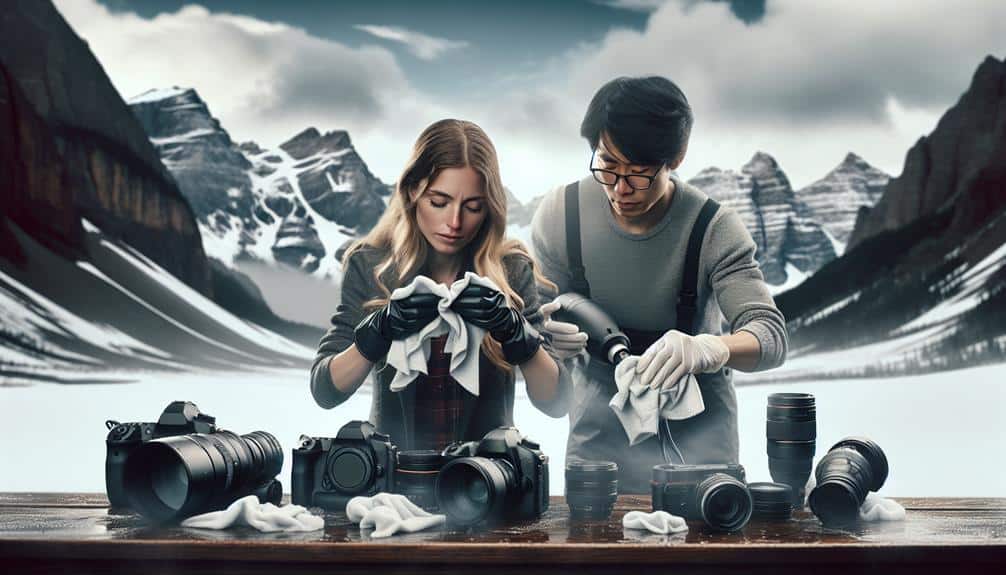
To effectively dry and clean your camera gear after exposure to extreme weather, start by using a microfiber cloth to gently remove moisture from the exterior surfaces. This immediate action is essential for equipment maintenance and preventive care.
Next, let's delve into a more detailed procedure:
- Remove Batteries and Memory Cards: Open the compartments and carefully take out the batteries and memory cards. This guarantees that no residual moisture causes internal damage.
- Use Silica Gel Packs: Place silica gel packs inside your gear storage. These packs are excellent for humidity control and help absorb any remaining moisture within the camera body and lenses.
- Air Dry in a Controlled Environment: Allow your equipment to air dry in a room with controlled humidity. Avoid direct sunlight or heat sources which can lead to rapid temperature changes and potential damage.
- Clean Lens and Sensor with Specialized Tools: Utilize a lens cleaning solution and sensor swabs specifically designed for camera equipment. This ensures that you're not using abrasive materials that could scratch or damage sensitive components.
Frequently Asked Questions
Can Extreme Temperatures Damage the Camera's Internal Electronics?
Yes, extreme temperatures can damage the camera's internal electronics. We must also consider the impact on batteries and effects on lens coatings, which can impair performance. Proper precautions guarantee our gear operates reliably, preserving our creative freedom.
How Can I Prevent Condensation Inside My Camera Body?
To prevent condensation inside our camera body, we should focus on moisture prevention. Guarantee camera seals are intact, avoid sudden temperature changes, and use silica gel packets. To combat lens fogging, store gear in airtight bags.
What Precautions Should I Take When Shooting in a Sandstorm?
When shooting in a sandstorm, we should prioritize sandstorm precautions and camera protection by using protective covers and sealed lenses. Gear maintenance is essential, so clean equipment thoroughly after exposure to guarantee longevity in extreme weather conditions.
Are There Specific Materials to Avoid When Selecting Camera Gear for Extreme Weather?
When it comes to extreme weather, let's not beat around the bush. We should avoid cheap plastics. Instead, opt for waterproof options and materials with impact resistance. They guarantee our gear stands up to the elements and stays safe.
How Do I Maintain Camera Functionality in High Humidity Environments?
To maintain camera functionality in high humidity, we should focus on moisture control and lens fogging. Using silica gel packs, ensuring camera seals are intact, and employing other protection measures will safeguard our gear effectively.
